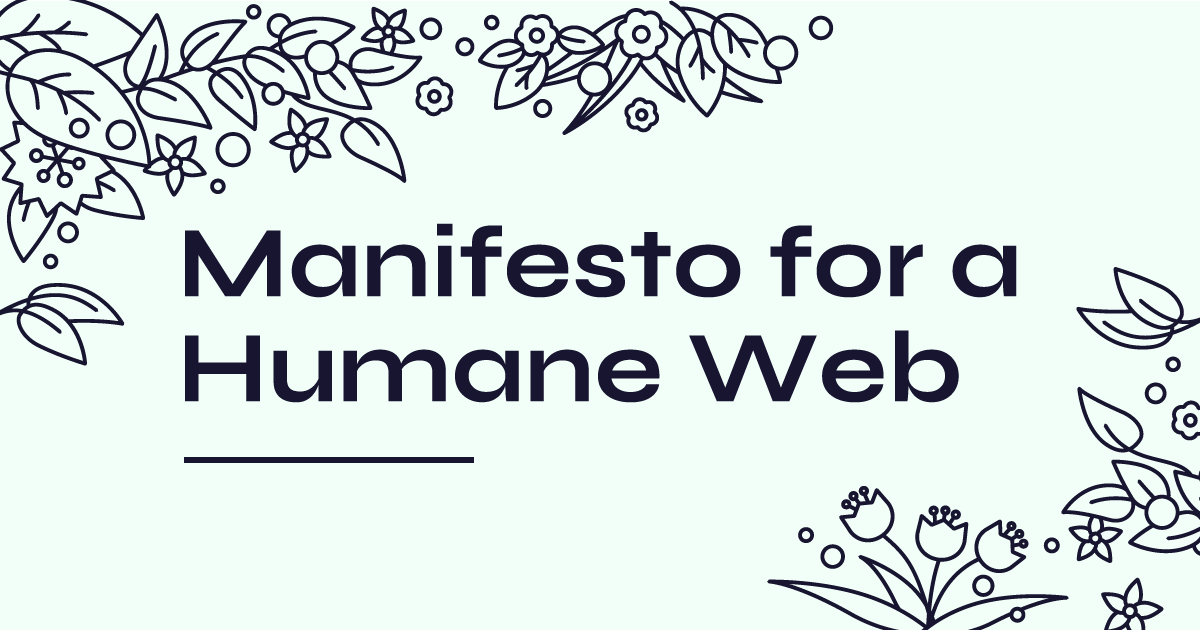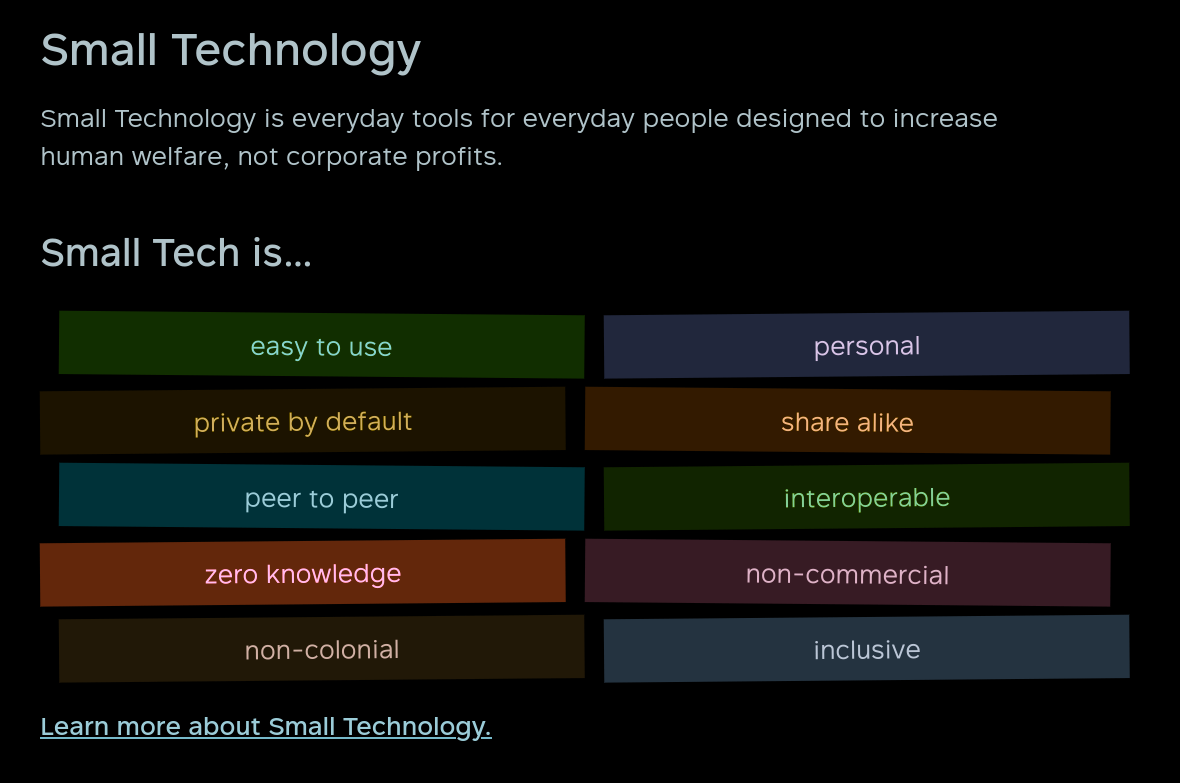There’s many manifesto websites dealing with various aspects of better technology alignment to people and society. This list topic is meant to keep track of them…
Humane Web Manifesto
Created by Michelle Barker.
We need a web by and for humans.
The good news is, rebirth is possible. A humane web can rise from the ashes. Life can flourish in the dirt. By tending our safe havens in our own corners of the web, and by sharing with our friends and neighbours, away from the gaze of monolithic corporations, a new web can thrive. We can rewild the internet4.
If what we don’t want from the web is increasingly clear, perhaps it’s time to identify what kind of web we do want. How do we define a humane web?
This manifesto is intended as a personal response to the current state of the web. It is a statement of intent and a call to arms, inviting you, the reader, to go forth and build humane websites, and to resist the erosion of the web we know and love. It reflects my thoughts and feelings at the time of writing, but it is not “complete”. The definition of a humane web should grow and evolve over time.
Created by Wholegrain Digital.
We need a sustainable internet
We all share and use the web, just as we all share and live on this planet. This manifesto is a public declaration of a shared commitment to create a sustainable internet.
The planet is experiencing unprecedented climate change and the Internet is both part of the problem and the solution. From websites to cryptocurrencies, the Internet consumes large amounts of electricity in data centres, telecoms networks, and end user devices. If the Internet was a country, it would be the 4th largest polluter in the world and is expected to grow considerably by 2030.
If we embrace sustainability in our work, we can create a web that is good for people and planet. By signing this manifesto you declare your commitment to create a greener web.
Created by Brad Frost.
It’s quite simple really:
- Respect people and their time.
- Respect your craft.
- Be sincere.
- Create genuinely useful things.
Somethign I struggled to remember yesterday:
Created by Wim Vanderbauwhede (published on Codeberg).
The problem:
The current emissions from computing are about 2% of the world total but are projected to rise steeply over the next two decades. By 2040 emissions from computing alone will be more than half the emissions level acceptable to keep global warming below 1.5°C. This growth in computing emissions is unsustainable: it would make it virtually impossible to meet the emissions warming limit.
The emissions from production of computing devices far exceed the emissions from their electricity usage, so even if devices are more energy efficient producing more of them will make the emissions problem worse.
The CO₂ emissions from the internet infrastructure resulting from individual internet usage are also very large and growing steeply because of the increased use of higher-resolution video and VR/AR.The solution:
As a society we need to start treating computational resources as finite and precious, to be utilised only when necessary, and as effectively as possible. We need frugal computing: achieving the same results for less energy.
Developer actions:
- Make software that works on older devices, the older the better.
- Make software that will keep on working for a very long time.
- Make software that uses the least amount of total energy to achieve its results.
- Make software that also uses the least amount of network data transfer, memory and storage.
- Make software that encourages the user to use it in a frugal way.
Thanks, @onepict, for bringing this to my attention.
Keith Kurson added a note on The internet used to be fun
linking to The internet used to be fun by Rachel J. Kwon with the comment:
Excerpt:
Personal website manifestos
This is an example list of links to personal websites making the case that the internet used to be more fun, and that it can be again. How to build, how to enjoy, and how to internet in general.
Data-centric Manifesto
“We have uncovered a root cause of the messy state of Information Architecture in large institutions and on the web today. It is the prevailing application-centric mindset that gives applications priority over data. The remedy is to flip this on its head. Data is the center of the universe; applications are ephemeral.”
HTML First
HTML First is a style of writing web software that favours using the native capabilities and languages of the browser and reducing layers of abstraction (languages and toolchains) on top of them.
HTML First Best Practices
These Practices are not Dictatorially Prescriptive. You don’t have to strictly follow them all in order to be “Doing HTML First Right”.
- Apply The Principle of Least Power
- Prefer Vanilla approaches
- Disfavor Build Steps
- Minimize Client Side State (Use the server)
- Be View-Source Friendly
If there’s one thing I’d like you to take away from this site, it’s that it is possible, practical, and perfectly reasonable, to build beautiful, fast, easy-to-use, accessible web software using primarily the native languages and capabilities of the web.
Save Social
Saving social media as a democratic force. […] Our society needs other platforms for social networking, exchange and debate than those provided by Chinese and US monopolistic corporations. Over the past 15 years, such alternative networks and services have emerged (for example Mastodon or Friendica in Fediverse4). They can strengthen our democracy because they promote social exchange and debate on the basis of open and recognised standards 5 in decentralised structures. Politics and society must strengthen and expand these services.
Small tech / Small web / Web0
Small technology and the Small web and previously Web0 (now archived) for the decentralized web, are delightful manifesto’s and valuable ideas for paradigm shifts that are passionately advocated by Aral Balkan and Laura Kalbag for years now. And they are putting them in practice, creating exemplaric software to clearly demonstrate the merits of the approach.
Perma Web
The Perma Web is a manifesto by @mro the developer of Seppo.
By using the “Perma Web” banderole, a website commits itself to both
- preservation of the biosphere (e.g. low energy consumption),
- respecting its visitors (including compliance with the GDPR),
- longevity (Cool URIs don’t change), as well as
- craft tradition (compliance with appropriate web standards) and
- respecting the Permacomputing Principles.
The page refers to a number of other websites to test the ‘compliance’ to these principles. Very nice.
Permacomputing principles
Contemporary permaculture is founded on three core ethics: Earth Care, People Care, and Fair Share. These ethics serve as a guiding compass for its design principles, co-creating a holistic framework for regenerative living. Similarly, permacomputing is built upon 10 principles that encourage and raise awareness about more sustainable digital practices.
The 10 principles listed are…
- Hope for the Best, Prepare for the Worst
- Care for All Hardware — Especially the Chips
- Observe First
- Not Doing
- Expose The Seams
- Consider Carefully The Interaction Between Simplicity, Complexity and Scale
- Keep It Flexible
- Build On Solid Ground (
 )
) - (Almost) Everything has a place
- Integrate Biological And Renewable Resources
SOFA
I recently overheard a conversation where this was shared.
Start Often Finish rArely
Start Often Fuck Achievements
SOFA is the name of a hacker/art collective, and also the name of the principle upon which the club was founded.
The point of SOFA club is to start as many things
as possibleas you have the ability, interest, and capacity to, with no regard or goal whatsoever for finishing those projects.The goal is acquiring many experiences. The side effects include entertainment and increased skill.
Here are some ways to get starting with SOFA:
- Start reading lots of books. If you don’t like a book you’re reading, stop reading it and put it down. Maybe give it away.
- Start a new code or art project. Get at least as far as writing a detailed README. Maybe you complete the project, or maybe you never get further than that. It’s fine.
- Start learning a new language. Spoken or computer. Just start, you don’t have to commit to mastering it. Open up duolingo[2] or exercism[3] and just do a few practice exercises.
Secret sauce, rationale and tips shared on the page as well.

